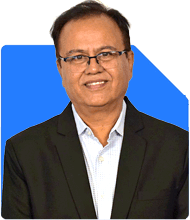Ramalingam Kalirajan |10923 Answers |Ask -Follow
Mutual Funds, Financial Planning Expert - Answered on Jul 04, 2025
He has an MBA in finance from the University of Madras and is a certified financial planner.
He is the director and chief financial planner at Holistic Investment, a Chennai-based firm that offers financial planning and wealth management advice.... more

Hellow sir. being a PSU employee ( age 35) and basic salary of 80k, I dont have much worry about the mediclaim ( which is free for my family and parents ) or PF & NPS ( which is sufficient considering basic salary ), I have following saving in my pack. 1. PPF 30L ( contributing 1.5L/ yr) 2. MF of valuation 43L ( contributing 50k/ month) 3. Fixed deposit around 12L 4. LIC around 50k / yr. 5. No loan. 6. No home under my ownership . What additional investment can be done for securing the future .
PPF: Rs?30?lakh (investing Rs?1.5?lakh annually)
Mutual funds: Rs?43?lakh (SIPs of Rs?50,000 monthly)
Fixed deposit: Rs?12?lakh
LIC: premium Rs?50,000 per year
No loans or home ownership
Comprehensive health and retirement cover via PF/NPS/mediclaim
You ask: What additional investment can secure your future? Let us create a holistic 360° plan using clear steps.
1. Recognise Your Strong Foundations
Your current holdings are robust:
Long?term safe savings via PPF
Active equity exposure via mutual funds
Liquidity from fixed deposits
Insurance through LIC for protection
Complete health and retirement cover
You are well-structured, but there is room to improve diversification, liquidity, and retirement readiness.
2. Define Clear Future Goals
Investment decisions depend on your aims. Let’s identify:
Retirement corpus by age 60
Income generation in retirement
Child education/marriage fund if planning
Short-term needs, like vacations or car purchase
Legacy planning for your family
Once goals and timelines are clear, we can allocate funds optimally.
3. Reevaluate LIC Insurance
Your annual LIC premium of Rs?50,000 covers insurance plus investment.
These policies often give low returns and high charges.
Recommend: Consider surrendering this policy
Redirect its premiums into actively managed mutual funds through regular plans
This enhances return potential and gives flexibility
Discuss surrender benefits and insurance needs with a Certified Financial Planner to ensure continued protection.
4. Reduce Fixed?Rate Concentration
Your fixed deposit of Rs?12?lakh offers liquidity but very low interest.
Instead, allocate:
Short?term debt or liquid funds for emergencies
Conservative hybrid funds for better tax-adjusted income and moderate growth
Debt mutual funds for laddered income while protecting capital
These will give better returns than fixed deposits and remain accessible.
5. Optimization of Mutual Funds Portfolio
You have Rs?43?lakh in mutual funds with Rs?50k monthly SIP.
Questions to assess:
Are these active funds or index funds?
Do you have a diversified basket (large?cap, multi?cap, hybrid etc.)?
Are they direct or regular plans?
Avoid index funds: they simply mirror market performance and offer no downside defence.
Avoid direct plans: you miss personal guidance from an MFD?CFP. Errors in choice or timing can cost more than fee savings.
Hence:
Continue with actively managed funds
Use regular plans, not direct
Diversify objectives across equity, growth, and risk
Increase SIP gradually every year, ideally by 10–15%
6. Strengthen Retirement Planning
Your PPF is good for conservative savings with long?term tax-free returns.
However, consider practical moves for post-60 income:
Open a systematic withdrawal plan (SWP) from hybrid and debt funds for monthly income
Keep part of corpus in equity for inflation protection
If you plan to retire early, maintain larger liquidity and low-risk assets
The aim: ensure steady income from your investments after retirement beyond what PF/NPS provides.
7. Introduce Hybrid Funds for Income
Hybrid funds provide stability plus moderate growth.
Allocate a portion (say Rs?10–15?lakh) for:
Conservative hybrid funds: 65–75% debt, 25–35% equity
Monthly withdrawals via SWP to create reliable income
Equity buffer ensures inflation protection
Professionally managed to reduce risk
Make sure these are active funds and continue with regular plan route via certified advisor.
8. Maintain Adequate Liquidity
Your fixed deposit offers liquidity, but redesign is recommended:
Maintain Rs?3–5?lakh in liquid funds for emergencies
Spread rest into short-term debt for better returns and tax efficiency
Avoid tying up more than 6 months’ expenses in illiquid instruments
This keeps your portfolio agile and responsive to unplanned needs.
9. Increase Equity Exposure Smartly
To grow beyond inflation, equity exposure is essential.
Add active equity funds with a long-term horizon
Keep allocation within risk tolerance (say 30–40% of total corpus)
Avoid index funds—they don’t offer growth potential beyond market
Regular plan mutual funds through MFD–CFP ensure goal alignment and periodic review
This step helps build a sizable corpus converting long-term savings into wealth.
10. Consider Tax?Efficient Long?Term Instruments
With primary instruments in PPF and mutual funds, consider:
Sukanya Samriddhi-like plan if you have a daughter, offering high tax-free returns
Corporate debt-oriented hybrid funds if you want higher income and safety
Short-term gilt or credit funds for better tax harvesting when needed
Hold these under guidance to ensure optimal after-tax gain and portfolio balance.
11. Systematic Corpus Withdrawal for Retirement
Estimate your retirement corpus via desired monthly income:
Example: Rs?50,000 monthly income requires Rs?1?crore at 6% withdrawal rate
Plan blended portfolio: equity, hybrid, debt
Use SWPs starting just after retirement
Align withdrawal with tax brackets to avoid large LTCG hits
This provides a financially secure retirement phase.
12. Annual Monitoring and Rebalancing
Periodic portfolio review is key:
Rebalance equity/debt ratio yearly
Adjust allocation as goals approach
Increase SIPs in line with salary increments and inflation
Add/remove funds based on performance, risk, and market conditions
This adaptive approach keeps you aligned with evolving financial needs.
13. Child and Legacy Planning
If you plan for your children or wish to leave a legacy:
Open PPF account in child’s name
Set up child education SIPs in active equity funds
Use staggered investment to fund education expenses
Draft a will or nomination documentation for smooth transfer
This safeguards your child’s future without burdening estate administration later.
14. Avoid Common Missteps
Don’t invest in index funds—they lack active risk management
Don’t choose direct funds—they lack professional review
Don’t buy annuities—they reduce asset flexibility
Don’t invest more in real estate—it lacks liquidity and income focus
Stay disciplined in your plan with professional support for steady results.
15. Action Plan Implementation
Immediate (next 1–2 months):
Surrender LIC investment policy blocks saving
Move FD into liquid/debt/hybrid funds
Build Rs?3–5?lakh emergency buffer
Enhance SIPs into active equity funds via regular plans
Short-term (next 6–12 months):
Add hybrid funds for monthly income
Shift surplus to PPF or Sukanya-like child fund
Build child SIP for daughter’s future
Review insurance and NPS contributions
Annual:
Monitor asset allocation
Rebalance equity/debt split
Increase SIP amounts yearly
Adjust SWPs closer to retirement goals
With this disciplined roadmap, you’ll build wealth, income, and future financial security.
Finally
Your financial position is strong already—PPF, MF, FD, insurance.
By tightening liquidity buffers, shifting LIC, enhancing equity and hybrid exposure, and following a disciplined retirement roadmap, you can ensure income and security.
Avoid index funds, go with active mutual funds through regular plans, and rebalance annually.
This structured, goal-based approach will help your future remain secure no matter what lies ahead.
Best Regards,
K. Ramalingam, MBA, CFP,
Chief Financial Planner,
www.holisticinvestment.in
https://www.youtube.com/@HolisticInvestment
You may like to see similar questions and answers below
Ramalingam Kalirajan |10923 Answers |Ask -Follow
Mutual Funds, Financial Planning Expert - Answered on May 11, 2024
Ramalingam Kalirajan |10923 Answers |Ask -Follow
Mutual Funds, Financial Planning Expert - Answered on Jul 10, 2025
Ramalingam Kalirajan |10923 Answers |Ask -Follow
Mutual Funds, Financial Planning Expert - Answered on Jul 06, 2025
Sunil Lala | Answer |Ask -Follow
Financial Planner - Answered on Jul 18, 2025
Ramalingam Kalirajan |10923 Answers |Ask -Follow
Mutual Funds, Financial Planning Expert - Answered on Aug 18, 2025
Ravi Mittal |679 Answers |Ask -Follow
Dating, Relationships Expert - Answered on Dec 22, 2025
Ramalingam Kalirajan |10923 Answers |Ask -Follow
Mutual Funds, Financial Planning Expert - Answered on Dec 22, 2025
Ramalingam Kalirajan |10923 Answers |Ask -Follow
Mutual Funds, Financial Planning Expert - Answered on Dec 22, 2025
Ramalingam Kalirajan |10923 Answers |Ask -Follow
Mutual Funds, Financial Planning Expert - Answered on Dec 22, 2025
Ramalingam Kalirajan |10923 Answers |Ask -Follow
Mutual Funds, Financial Planning Expert - Answered on Dec 22, 2025
Ramalingam Kalirajan |10923 Answers |Ask -Follow
Mutual Funds, Financial Planning Expert - Answered on Dec 22, 2025
Ramalingam Kalirajan |10923 Answers |Ask -Follow
Mutual Funds, Financial Planning Expert - Answered on Dec 22, 2025
Ramalingam Kalirajan |10923 Answers |Ask -Follow
Mutual Funds, Financial Planning Expert - Answered on Dec 22, 2025
Ramalingam Kalirajan |10923 Answers |Ask -Follow
Mutual Funds, Financial Planning Expert - Answered on Dec 22, 2025
Ramalingam Kalirajan |10923 Answers |Ask -Follow
Mutual Funds, Financial Planning Expert - Answered on Dec 22, 2025






















